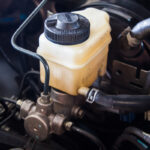
In order to prevent leather seats from becoming permanently discolored or saturated with sweat, you should learn how to preserve and seal them before they absorb too much of the unwanted liquid. In this article, I’ll show you how to seal leather car seats and how to protect them.
While there are many ways to do this, it is important that you use the right products for your car’s specific type of leather. This article will also discuss the different types of leather that can be found in automobile upholstery and what preservation steps will need to be taken for each type.
Table of Contents
Understanding Automotive Leather
Leather can come in many different types since it is a combination of animal, vegetable, and mineral fibers.
Vegetable leather is the most common type of leather used in automobiles. Vegetable leather is formed by tanning the skins of animals (such as cows, sheep, pigs, or horses) with water and vegetable extracts (such as the roots and leaves of plants such as oak trees). These hides are then usually tanned with another vegetable extract called “tannin” (such as oak leaves, pine needles, or pine bark).
Black vegetable leather is used extensively in upholstery in automobiles because it’s often the most affordable and durable.
What Does Sealing Leather Mean?
Sealing leather refers to the process of applying a protective coating or sealant to the surface of the leather material. The sealant forms a barrier that helps prevent damage from spills, stains, fading, and everyday wear and tear. It acts as a shield, creating a layer of protection that helps keep the leather looking fresh and extends its lifespan.
Sealing leather also aids in preserving the natural beauty and suppleness of the material, keeping it soft and preventing it from drying out or cracking over time.
Benefits of Sealing Leather Car Seats
Sealing leather car seats has many benefits that make it worth the investment.
Prevent damages

First and foremost, leather seats are prone to damage and decay due to their constant exposure to sunlight, moisture, and other environmental factors. The sealing process protects the leather from these damaging elements, thereby preventing cracks, fading, and discoloration.
Increase its longevity
In addition to aesthetic benefits, sealing leather car seats also improves their durability and longevity. Sealed leather resists stains, spills, and scratches, making it easier to clean and maintain. This is especially critical for car owners who frequently drive in muddy or dusty areas, as keeping leather seats in pristine condition can be challenging without sealing them.
Bring comfort
Sealed leather seats are more comfortable than non-sealed ones. This is because the sealing process nourishes the leather and prevents it from drying out or becoming stiff over time. As a result, sealed leather seats are softer, smoother, and more luxurious to the touch, providing a comfortable ride for drivers and passengers alike.
What Is Leather Sealant for Car Seats?
A leather sealant for car seats is a specialized product designed to provide a protective coating for leather surfaces in cars. It is formulated to safeguard the leather from various factors that can cause damage, such as UV rays, spills, stains, fading, and general wear and tear. The sealant creates a barrier on the leather surface, helping to repel liquids, dirt, and other contaminants.
Also, it can enhance the leather’s resistance to cracking, drying out, and premature aging, while also maintaining its natural look and feel.
Applying a leather sealant regularly can help preserve the appearance and longevity of car seats made of leather.
How to Seal Leather Car Seats
Tools Needed
- Leather Conditioner and/or Leather Protector
- Soft Cloth
- Clean Microfiber Towel (for leather that is greasy or oily)
How to Seal Leather Car Seats Instructions:
# Pre-Cleaning
If the leather isn’t already very clean, you can clean it using a damp cloth. This will remove any dirt and debris that could cause the leather to appear dull. After cleaning the seat, you can apply either a conditioner or protector cream to seal it.
Read more: Is it possible to pressure wash your car’s seat belts?!
Note:
- Conditioners can be used on dry car leather that needs a little help to make it look smooth. However, conditioners may not work well on very oily surfaces because they do not penetrate as deeply as protectors.
- If the seat’s leather is greasy, you’ll need to use a protector instead of a conditioner. And, if the leather is very smooth and shiny (due to frequent cleaning), the best thing to do is leave it alone.
#Step 1: Rinse the Leather
Rinse the leather with lukewarm water to remove any dirt or grit.
#Step 2: Apply a Leather Conditioner
Using a soft cloth, apply a leather conditioner (with a sufficient amount of product) throughout the leather surface to lubricate it. This will prolong the life of the material and prevent it from cracking or becoming dry and brittle.
You can individually brush each side of each panel if you prefer, but it isn’t necessary unless you want to get a smoother, cleaner look.
#Step 3: Let it Dry
Let it dry for at least five minutes.
#Step 4: Apply a Leather Protector
Apply a leather protector (with a sufficient amount of product) to thoroughly cover and seal the leather. This will prevent the color from fading and keep it from drying out or becoming stiff over time. It will also help protect the seat from abrasion, cracking, scratching, and staining.
Note:
You can either use a microfiber towel or a terry cloth towel to scrub the residue off:
- If you are using a microfiber towel, use it with surface tension to easily remove dirt and grease from the car seat. Use a soft pressure while rubbing in circular motions. Don’t rub hard or harshly or you risk damaging the seat’s finish.
- If you are using a terry cloth towel, use it with surface tension to easily remove dirt and grease from the car seat. Use your fingers to rub gently in circular motions to avoid scratching the leather finish.
- After removing the residue, apply a leather protection cream to restore the original finish.
Common Mistakes to Avoid when Sealing Leather Car Seats
Common mistakes made during the sealing process can damage the leather beyond repair. Here are some common mistakes to avoid when sealing leather car seats:

1. Using the Wrong Sealant
Using the wrong sealant can cause significant damage to the leather. Avoid using water-based or acrylic sealants, as they can dry out the leather or leave residue that may cause discoloration. Instead, use a sealant specifically designed for leather upholstery.
2. Over Applying
Applying too much sealant can cause the leather to become stiff and crack over time. Follow the instructions on the sealant carefully and apply it in thin layers to achieve the desired results.
3. Not Preparing the Leather
Preparing the leather before applying the sealant is essential to achieving a smooth and even surface. Cleaning the leather with a leather cleaner and then using a conditioner to moisturize it will ensure that the sealant adheres properly.
4. Skipping the Test Patch
Skipping the test patch can lead to undesirable results. Always perform a small test on an inconspicuous part of the leather before applying the sealant to the entire surface.
5. Ignoring the Drying Time
Allowing the sealant to dry completely is essential to its effectiveness. Skipping the drying time or using the car before the sealant has dried can lead to unsightly marks on the leather.
How Often Does Leather Need Sealing?
You should seal the leather in your car at least once a year. If you use a lot of seat covers, this may need to be done every 3-4 months. It is also recommended that you apply more coats of protection if your vehicle is exposed to harsh weather conditions (such as snow and rain) on a regular basis. This will help protect the upholstery from becoming permanently damaged over time.
Check out: How to clean car seat belts RIGHT!?!
To check if your leather needs to be sealed, drop a bit of water on the leather surface. If it is great water-repellent, then you can leave it for a while.
Is Sealing the Leather Necessary?
If you want to keep the leather in your car nice and new, sealing is important to protect the upholstery from drying out and cracking. Sealing the leather will also prevent it from becoming greasy or oily since it provides a barrier against liquids. This will help keep your car looking clean and feeling soft for longer.
How to Care for Leather Car Seats
Leather is a very durable material, but it does have some limitations. When these are taken into account, there are several things you can do to prolong the life of your leather upholstery. The following points will help you keep your car looking and feeling its best for longer.
# Preventing Leather from Getting Cracked
Leather is prone to cracking over time. This happens when the leather dries out due to water, heat, and humidity exposure. When this happens, you can keep the leather looking good for longer by regularly applying a leather conditioner (or sealer). If you notice cracks, then you should apply a conditioner or sealer with a brush or cloth to properly protect it or it might look dirty in no time.
Wondering: How to prevent water spots on cars EFFECTIVELY!?
# How to Preserve Soft, Smooth Leather
If you want to keep your leather looking nice and new for a long time, you should avoid using any hard brushes or chemicals on it. Failing to do this will cause the leather surface to become dull and brittle over time.
Over-cleaning the seat with harsh products can also cause it to be damaged easily over time. So, it’s important to clean the leather often but without using too much force or friction.
# How to Care for Leather Upholstery in General
If you want to keep your leather looking nice for a long time, it’s important to:
1. Keep it Dry
If the leather is exposed to water or moisture, then the cells of the upholstery will begin to lose their natural oils and break down. This will cause the leather surface to become sticky and look dull.
2. Keep it Clean
You should avoid using harsh chemicals on your leather upholstery. These can damage it over time and can even cause the upholstery to rot if you don’t clean it regularly. Also, leather upholstery is prone to staining from various substances such as oil, grease, wine, tea, coffee, and other substances. You should take care of this by cleaning it regularly with a dry cloth or a microfiber wipe.
3. Keep it Conditioned
You should condition your leather upholstery on a regular basis to keep it looking good and keep the leather surface soft and smooth.
Check out This Video for The 3 Biggest Mistakes Related to Car Leather Care!
Frequently Asked Questions
#1 What Is the Best Treatment for Leather Car Seats?
The best treatment for leather car seats is to keep them clean and conditioned. Cleaning the leather frequently (about once a month) will prevent it from becoming dirty and keep it looking great for longer. Conditioning the leather will prevent the leather from drying out which makes it less prone to developing cracks or wrinkles over time.
Find out: How to remove front car seats easily for cleaning!
#2 What Is the Best Leather Sealer?
The best leather sealer is a clear, non-drying, water-repellent sealer that will keep the leather surface soft, supple, and strong. You should apply it once every year or every 3 to 4 months if your vehicle is exposed to harsh weather conditions on a regular basis. Applying more coats of protection as necessary will help keep the leather looking and feeling good for longer.
#3 How Do You Waterproof Leather?
You can waterproof leather by:
- Cleaning it regularly with a damp cloth to remove stains and dirt from the surface.
- Applying a clear, water-repellent sealer to prevent the leather from drying out. Be sure to reapply this every year or three months to keep it looking new for longer.
- Using protective seat covers that will prevent the leather upholstery from getting wet during rain or snowstorms when you are traveling in your vehicle.
#4 Can you seal leather with Vaseline?
Final Words
To conclude, you should clean and protect your leather car seats every year or three months to keep them looking and feeling good for longer. Sealing the leather will also help it stay soft and supple so that you can use it comfortably for longer.
When choosing a sealant, make sure that it is water-repellent, clear in color, and does not contain any chemical that might cause a stain when applied on the leather surface. It should also be non-drying to prevent damage to the upholstery over time.
Further Reading:
- How to Clean Leather Car Seats
- Testing the effect of textile materials on car seat comfort in real traffic (Journal)
Hi everyone, My name is Ollie Barker.
As a seasoned auto expert I have 25 years of experience working in repair and detailing shops. I love to share my tips & tricks to all car lovers, so that’s why I’m here at Automotive Gearz publishing my content, sharing my passion. Also, I’ve been giving my recommendations on which products are the best to have on the market. I always thought it was hard to pick the right part, so hopefully I can make that a bit easier for you.
Hope you enjoy your time on my little blog!







